Fleas (Order: Siphonaptera) are highly specialised insects with more than 2500 species, worldwide. Adult fleas are small (~2–10 mm in length), dark brown, and blood-sucking insects. Although wingless fleas have strong hind legs adapted for leaping, allowing significant mobility.
As holometabolous insects fleas complete a life cycle from egg to adult through larval and pupal stages (Figure 1). A female flea lays up to 50 eggs per day and around 1500 in a lifetime. Fleas lay their eggs in the hair coat of the host, and because eggs are not sticky they fall off the host into the environment. Eggs usually hatch in about 2 to 5 days into larvae. Flea larvae are grub-like and feed on organic debris in the environment, such as flea faeces and dander (Rust and Dryden, 1997). Larvae tend to move away from light and burrow deep into carpets, under furniture or into cracks and crevices. Mature larvae develop into new adults inside a whitish, loosely spun silk-like cocoon, the pupa. Because it is sticky, the cocoon quickly becomes coated with environmental debris, which provides protection from insecticidal treatments and thus, pupae will continue to hatch after pets and the household have been treated. The pupal stage is often the key to an unresolved flea problem and it is thus paramount that veterinary practitioners, nurses and clients understand its complexities.
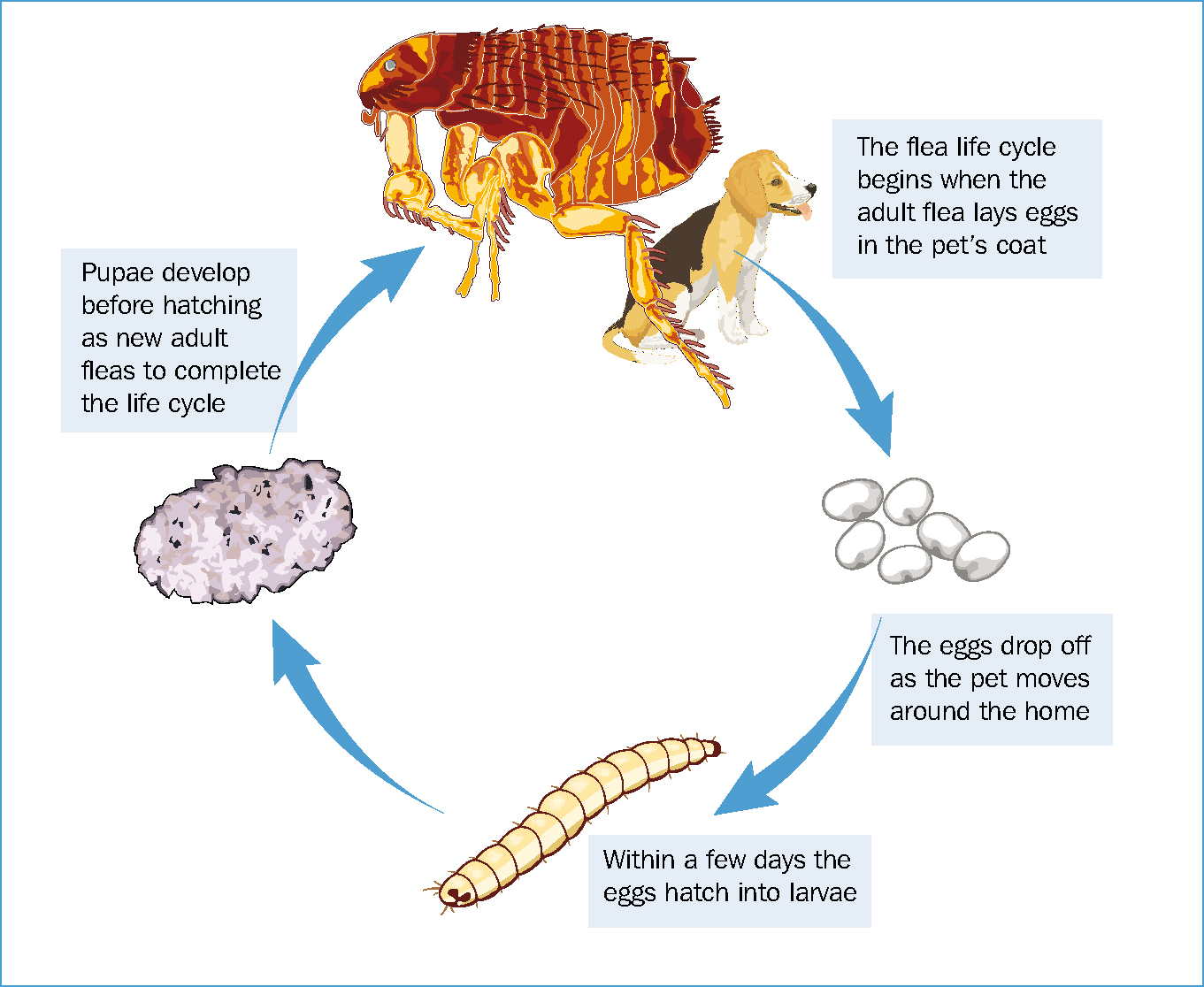
When the adult flea emerges from the cocoon, it immediately begins seeking a host for a blood meal. Fleas move towards light and prefer to move upward. As a result, newly hatched fleas move directly to the top of the carpet pile, bedding material, or other surface, where they are more likely to encounter a passing host. If a host is not immediately available, a newly emerged flea can survive for several days before acquiring a host and a blood meal. Once it is on the host the flea begins feeding within minutes (Dryden and Gaafar, 1991). The flea feeds through a long, slender mouthpart called a proboscis. Before feeding, the flea pumps anticoagulant-containing saliva into the wound to prevent the blood from clotting. Flea faeces (dirts) are produced within about 10 minutes of feeding. Fleas mate at about 8 hours of the flea taking their first blood meal and egg production begins at 24 hours. The adult flea is a permanent resident that will not leave the host voluntarily. Once a flea has fed on a host and has begun egg production, it becomes dependent on a constant blood source; thus adult fleas rarely jump from one animal to another. On the host, fleas can continue to survive and reproduce for 3 to 4 months.
Epidemiology of fleas
By far the most commonly seen on both dogs and cats is the ‘cat flea’ Ctenocephalides felis. On the other hand, the ‘dog flea’ Ctenocephalides canis is observed infrequently on dogs and rarely on cats, although may be found more commonly in more temperate climates, such as Ireland. Pulex simulans and Echidnophaga gallinacea (poultry sticktight flea) can also occur on dogs and cats.
The adult fleas which are seen on the pet are only the tip of the iceberg; 95% of the flea problem exists in the home as eggs, larvae and pupae (Figure 2). Under most household conditions, cat fleas complete their life cycle in 3–8 weeks (Blagburn and Dryden, 2009). However, the range could be from 2 weeks to 12 months depending on temperature and humidity, which impact the hatch times. Fleas are most numerous during warm summer months, however with fluctuations in climate and as homes are now centrally heated, fleas should now be considered a year round problem.
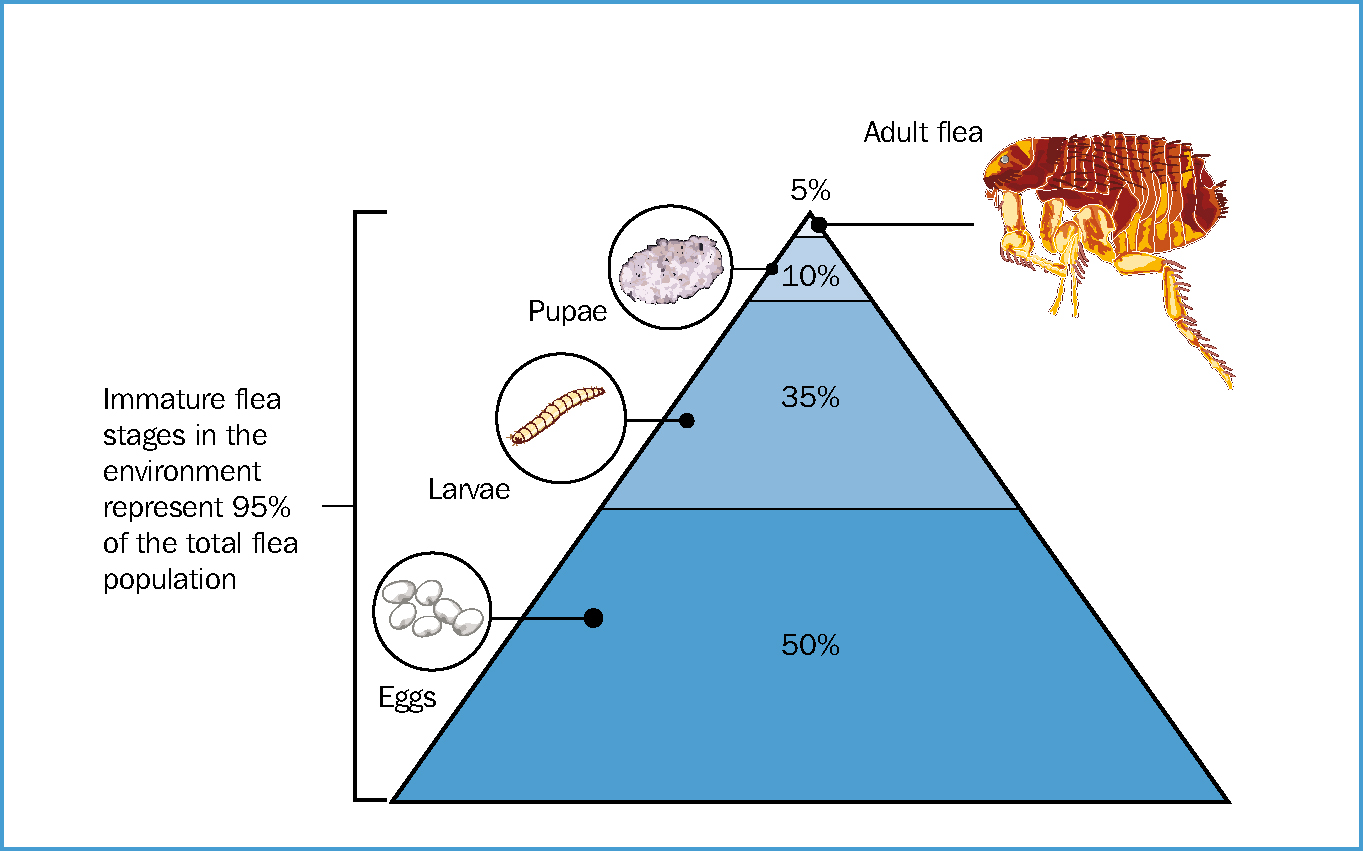
Veterinary and medical importance
Irritation
Fleas cause pruritus (itching) and irritation in affected cats and dogs. It is possible, however, for some pets to carry significant flea burdens without showing obvious signs. Cat and dog fleas can also feed on humans temporarily if they cannot find a dog or a cat host. This is manifested as small red bites around the ankle/calf region.
Anaemia
Because fleas feed on the pet's blood it is possible for them to cause iron deficiency anaemia, particularly in small kittens and puppies (Rust and Dryden, 1997). This blood loss can be life threatening in very small pets, or in pets that are ill for other reasons.
Flea allergy dermatitis (FAD)
Some cats and dogs suffer from an allergy to the flea dirt and/or saliva, leading to FAD (Elsheikha, 2012). This is one of the most common and serious skin diseases in dogs and a major cause of feline miliary dermatitis (Rust and Dryden, 1997).
Flea-borne diseases
Due to their haematophagous nature fleas can be vectors of various diseases in many parts of the world.
Diagnosis
A flea comb remains the mainstay of diagnosis and can be used to rapidly find adult fleas (Figure 3) or flea dirt (Figure 4). Flea dirt comprises mostly partially digested blood and will smear red on cotton wool or can be identified microscopically. Clients will sometimes find flea larvae and present them for identification (Figure 5).
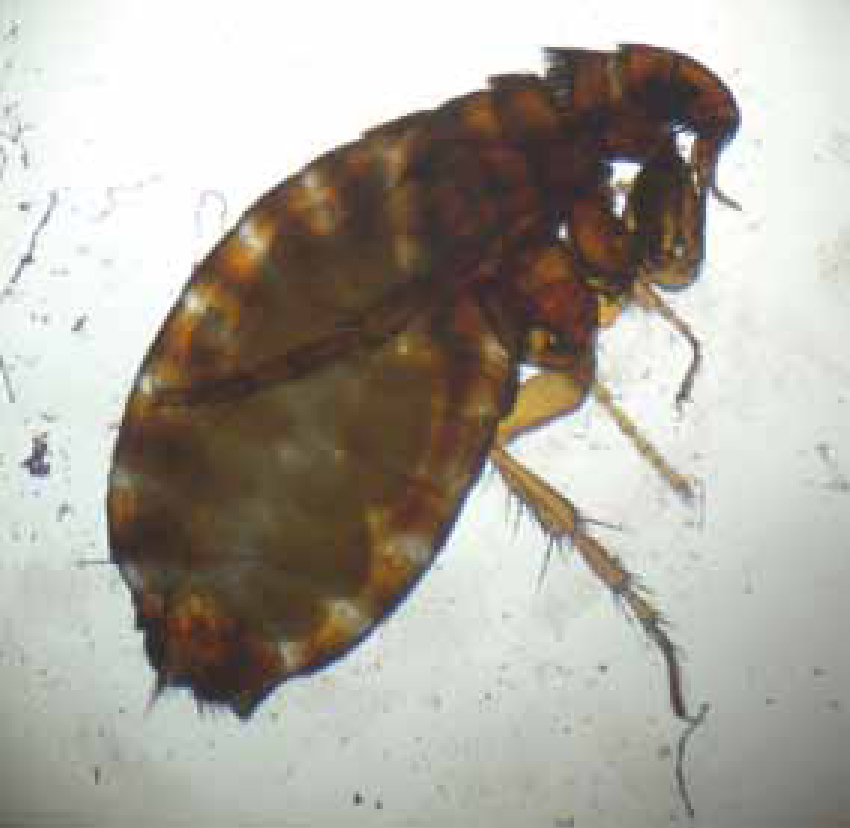
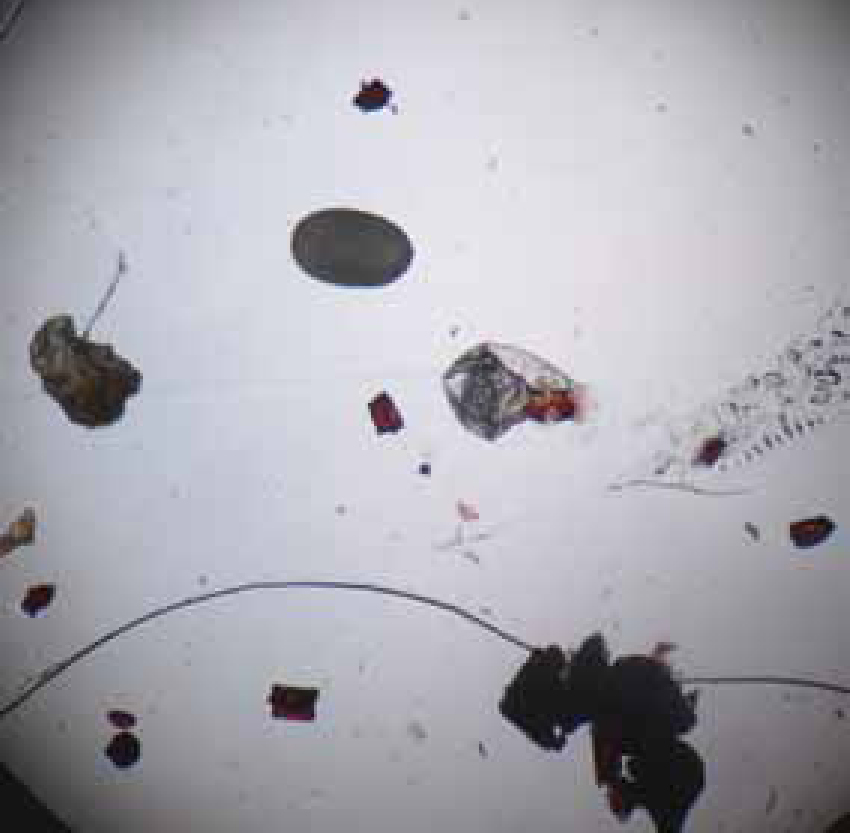
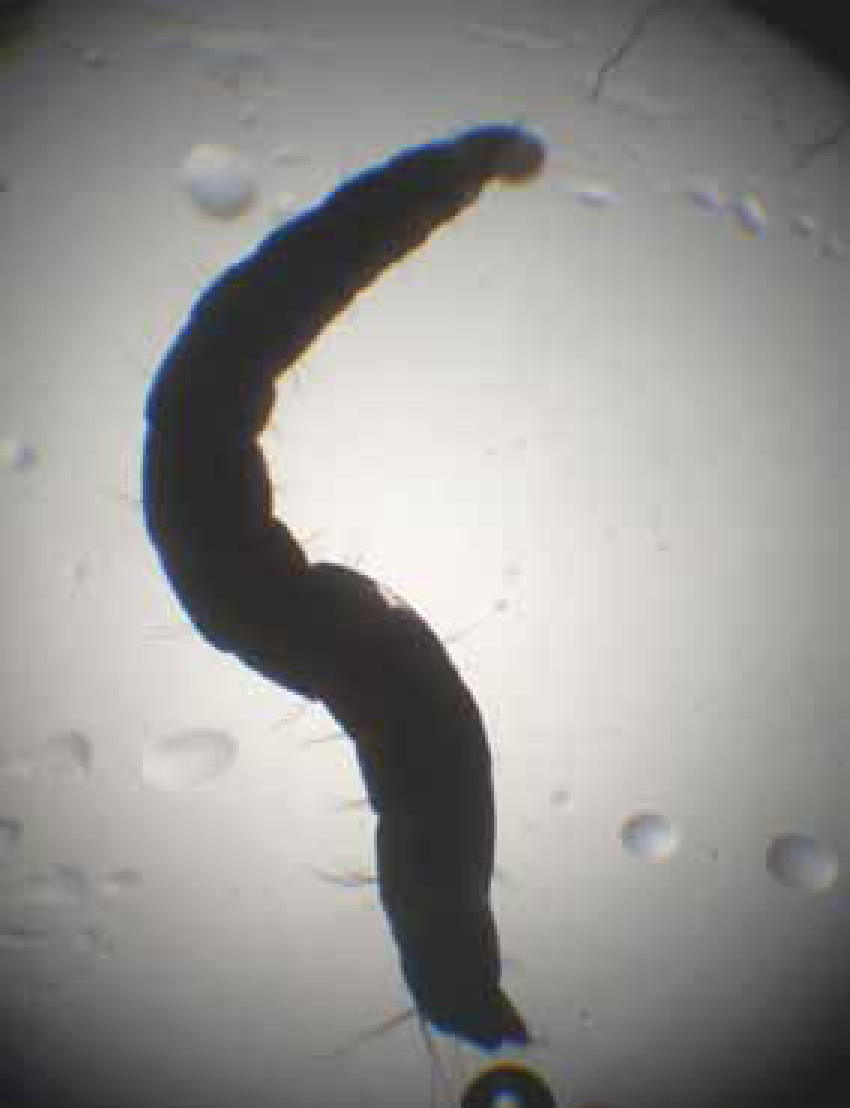
Treatment and prevention
Flea infestations on pets and in homes are becoming an increasingly common problem in the UK and attempts to eliminate infestations are expensive and take time to achieve. Up until the mid-1900s flea control relied on on-animal products without significant residual activity, Most of these products were effective at eliminating adult fleas but infestation would then often reoccur. The ‘holy grail’ of companion flea treatment was a pesticide with residual activity, wide safety margins for the patient and in a formulation that was convenient to apply. Fipronil in 1987 was the first of a series of compounds that met these criteria. These compounds used in combination with insect growth regulators have proved effective at eliminating flea populations from households. For flea elimination programmes to be successful adult fleas must be killed on the pet before they can initiate reproduction and egg production. While use of growth regulators and environmental insecticides are useful at controlling environmental populations no product will kill pupae in the environment and so effective rapid killing of adults is required to completely break the reproductive cycle. To achieve this good advice must be given, both in terms of recommending efficacious products and also correct method and frequency of application. Compliance is a pivotal factor and owner preference in terms of use of a spot-on preparation or tablet should also be considered. Often flea control will also form part of wider parasite control requirements, such as ticks and endoparasites. Giving this advice will often fall to veterinary nurses as advice is often sought at reception and nurse consultations rather than with the veterinary surgeon.
The objectives of flea control are three folds:
The flea product market is fluid with products constantly being introduced and withdrawn and so an exhaustive list of up-to-date available products is not possible, but examples of products containing these compounds are summarised in Table 1. Examples of efficacious compounds in flea control are:
| Active flea treating compound | Status | Preparations | Mode of administration | Species license |
|---|---|---|---|---|
| Fipronil | NFA-VPS, POM-V (Frontline combo®, Certifect®, Frontline spray®) | Frontline®, Frontline combo®, Certifect® (dogs only), Pestigon®, Effipro®, Vexitor®, Eliminall®, Fevox®, Fiproline®, Vexitor® | Spot on, spray | Cats, dogs, ferrets |
| Imidacloprid | NFA-VPS, POM-V (Seresto®, Advocate® and Advantix®) | Advantage®, Advantix® (dogs only), Advocate®, Seresto® | Spot on, collar | Cats, dogs, rabbits (Advantage), ferrets (Advocate) |
| Selamectin | POM-V | Stronghold® | Spot on | Cats, dogs |
| Pyriprole | POM-V | Practic® (dogs only) | Spot on | dogs |
| Nitenpyram | AVM-GSL | Capstar® | Tablet | Cats and dogs |
| Lufenuron | POM-V | Program® | Tablet, suspension, injectable | Cats and dogs |
| Indoxocarb | POM-V | Activyl®, Activyl plus® (dogs only) | Spot on | Cats and dogs |
| Dinotefuran | POM-V | Vectra 3D® (dogs only) | Spot on | Dogs |
| Spinosad | POM-V | Comfortis®, Trifexis® (dogs only) | Tablet | Cats and dogs |
| Afoxolaner | POM-V | NexGard® | Tablet | Dogs |
| Fluralaner | POM-V | Bravecto® | Tablet | Dogs |
Perceived product inefficacy
Ctenocephalides felis is thriving in the UK with successive mild winters and reservoir populations in centrally heated homes, and the persistence of fleas in the environment and visible fleas on the pet after application of flea products has led to questions of resistance. Despite numerous large scale studies into the efficacy of POM-V flea treatments fipronil and imidacloprid, there is currently no evidence of flea resistance in the field. Even where resistance genes are known to exist in laboratory strains of flea, fipronil, selamectin and spinosad have all been shown to be highly efficacious at 3 weeks post application (Bass et al, 2004; Dryden et al, 2013). The question then arises as to why resistance is perceived to be present when this is not the case in practice. There are numerous reasons why resistance may appear to be occurring. The lack of consideration of the following factors might lead to failure of control programmes and in some cases fleas will still be present despite the use of efficacious products.
Conclusions
Flea control is important in terms of human nuisance and revulsion, reducing vector-borne disease and the clinical signs resulting from flea infestation. Flea control continues to remain a challenge and it is vital for veterinary nurses and SQPs to remain up to date both in terms of new products coming onto the market, but also giving accurate advice. This includes frequency of application, compliance and management of client expectation when choosing what flea control products to employ.

